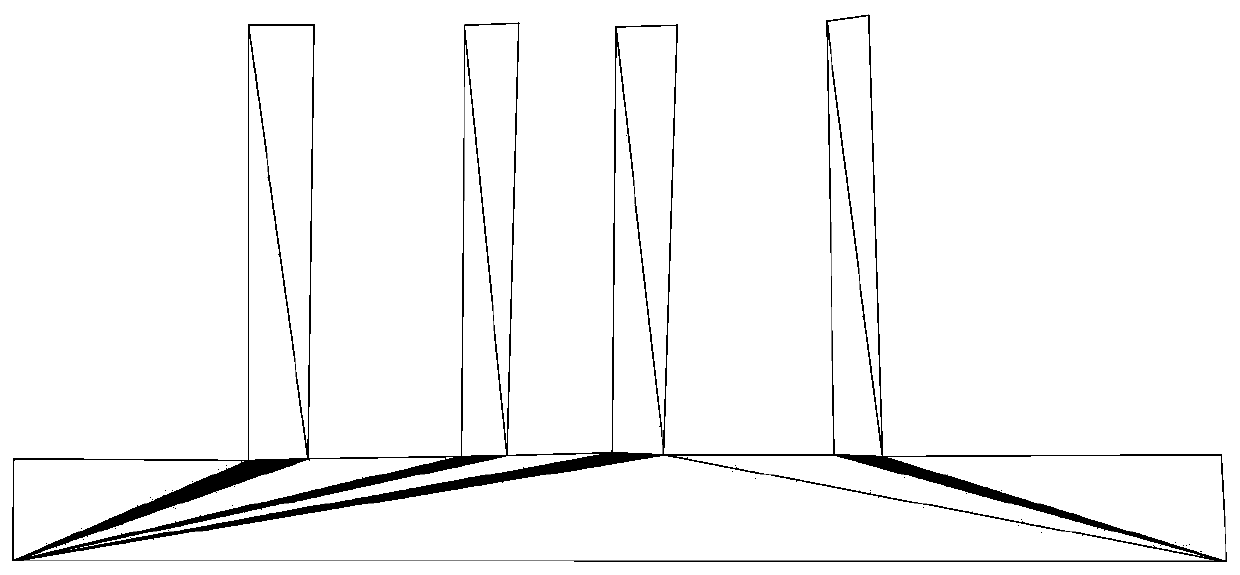A Skeleton Line Extraction Method for Dense Areas of Intersections
A dense area and extraction method technology, applied in the field of map drawing, to achieve scientific and accurate results
- Summary
- Abstract
- Description
- Claims
- Application Information
AI Technical Summary
Problems solved by technology
Method used
Image
Examples
Embodiment 1
[0058] Such as Figure 2 to Figure 6 As shown, the specific content of step S1 is described in detail in this embodiment, and the specific content of step S1 includes the following content, such as figure 2 Shown:
[0059] S101. Identify obtuse triangles in class III triangles in the constrained Delaunay triangulation, and set a minimum angle threshold, mark obtuse triangles with minimum angles smaller than the minimum angle threshold, and put them into a triangle set;
[0060] S102. Identify the longest sides of all triangles in the triangle set, and search for Class II triangles that are adjacent to these longest sides and have one side as a boundary;
[0061] S103. Select all II triangles whose longest sides are boundary sides, mark them as triangles to be encrypted, and mark their corresponding longest sides as local long sides to be encrypted;
[0062] S104. Set the shortest side of a type III triangle in the triangle set associated with the triangle to be encrypted as...
Embodiment 2
[0066] Such as Figure 7 to Figure 10 As shown, in this embodiment, step S3 is described, and the step S3 includes the following content, such as Figure 7 Shown:
[0067] S301. Construct point and line topology for the initial skeleton line, and record the number of associated arcs associated with each node in the skeleton line topology;
[0068] S302. Select a node whose number of associated arcs is three, the node is a three-fork node, and its area is a three-fork area;
[0069] S303. Calculate the local approximate width of the trifurcation area;
[0070] S304. Define the arc segment whose first and last endpoints are both three-fork nodes as a connecting arc segment; respectively calculate the local approximate width of the area where the first node and the end node of the connecting arc segment are located, and use the larger value as the connecting arc segment The local approximate width of the area;
[0071] S305, record the part between the first node and the end ...
Embodiment 3
[0082] Such as Figure 11 to Figure 13 As shown, this embodiment describes step S4, and the step S4 specifically includes the following content, such as Figure 11 Shown:
[0083] S401. Using the CRITIC method to weight the length, connectivity, proximity and betweenness of each connecting arc to obtain the importance of the connecting arc;
[0084] S402. Select a three-fork node with an associated arc on only one side as the starting node for stroke connection tracking, and use the connecting arc of the three-fork node as a tracking arc, and the other side of the tracking arc The node is used as a tracking node;
[0085] S403, using the connection arcs of the tracking nodes as a stroke connection candidate set, and calculating the importance of each connection arc;
[0086] S404. Prioritize connecting the more important connecting arc with the previous connecting arc to form a stroke;
[0087] S405. On the basis of steps S403 and S404, continue to track and calculate the ...
PUM
 Login to View More
Login to View More Abstract
Description
Claims
Application Information
 Login to View More
Login to View More - R&D
- Intellectual Property
- Life Sciences
- Materials
- Tech Scout
- Unparalleled Data Quality
- Higher Quality Content
- 60% Fewer Hallucinations
Browse by: Latest US Patents, China's latest patents, Technical Efficacy Thesaurus, Application Domain, Technology Topic, Popular Technical Reports.
© 2025 PatSnap. All rights reserved.Legal|Privacy policy|Modern Slavery Act Transparency Statement|Sitemap|About US| Contact US: help@patsnap.com



